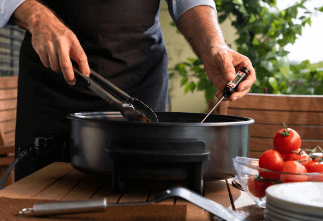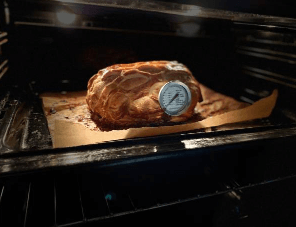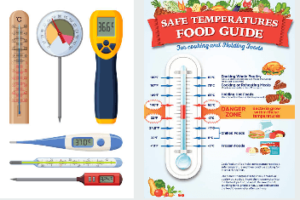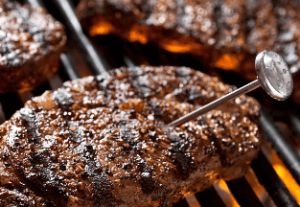How to Use A Cooking Thermometer?

If you’re not using a cooking thermometer, you’re not really cooking. That might sound like an exaggeration, but it’s true! A good cook always uses a cooking thermometer to ensure that his food is cooked properly. So, here comes the billion dollar question “how to use a cooking thermometer”.
Here’s how to use a cooking thermometer: First, decide what kind of food or meat/ poultry you’ll be cooking. Then, find the correct temperature for that particular food. The following parts will help you to use a cooking thermometer perfectly.
How to use a cooking thermometer?
You may find using a cooking thermometer is difficult like most people as a first time user. Don’t panic, read the follwing parts to learn how to use a cooking thermometer accurately for cooking a perfect meal. Different food items required different temperature for theirdoneness. For example, the expected internal temperature for cooking a chicken should be 165 degrees Fahrenheit.

Once you know the target temperature, insert the thermometer into the thickest part of the meat (without touching bone). Wait a few minutes until the reading stabilizes, then check the temperature.
If it’s lower than your target temperature, put the food back in the oven or on the grill and continue cooking until it reaches the correct temp.
- Stick the thermometer into the food you’re cooking
- Make sure it’s not touching any bones, as this will give you an inaccurate reading
- Wait a few minutes for the thermometer to register a temperature
- Check the internal temperature of your food against the USDA’s recommended temperatures for various meats, poultry, and seafood dishes
- Adjust your cooking time or method accordingly if necessary
How to Use Meat Thermometer Grill
Temperature control is one of the most crucial considerations when grilling. After all, you want to ensure that your meal is correctly prepared and neither undercooked nor overcooked. A meat thermometer is useful in this situation.
An overview of how to use a meat thermometer when grilling is stated below:
- Heat up your grill before you start cooking. By doing this, you can make sure that your food cooks evenly.
- Insert the thermometer’s point into the thickest portion of the meat before you begin cooking, being careful to avoid the bone.
- Cover the grill’s lid and let the meat cook until the appropriate temperature is reached. Use this graph as a reference:

- Rare: 115-120°F
- Medium-Rare: 121-125°F,
- Medium: 126-130°F,
- Medium-Well: 131-135°F.
- When the meat reaches the proper temperature, take it off the grill and let it rest for three to five minutes before slicing. This gives the meat time to disperse its juices evenly so that none of them pour out when you cut into it too soon.
And utilizing a meat thermometer is limited to that as well! Just keep in mind that it’s always better to be safe than sorry when cooking meat.
How to Use Meat Thermometer Chicken

Most people don’t realize how important it is to use a meat thermometer when cooking chicken. It’s crucial to ensure that your chicken is fully cooked because undercooked chicken might be harmful. The ideal tool for this is a meat thermometer.
Here’s how to cook chicken using a meat thermometer:
- Set the oven’s temperature properly. The internal temperature of chicken should be 165 degrees Fahrenheit.
- Put the chicken in the oven and stick the meat thermometer into the chicken breast’s thickest area.
- The chicken should be cooked until it reaches an internal temperature of 165°F. Use a timer as well, if necessary, as the cooking time will vary based on the size of the chicken.
- After the chicken reaches an internal temperature of 165 degrees Fahrenheit, take it out of the oven. Let it rest for a few minutes before carving or serving.
How to Use Meat Thermometer Chicken Breast
Use a meat thermometer to check the temperature of your chicken to make sure it is cooked through. The internal temperature of chicken breasts should be 165 degrees Fahrenheit. Here are some instructions for cooking chicken breasts with a meat thermometer:
- Avoid touching the bone by inserting the tip of the meat thermometer into the thickest section of the chicken breast.
- Wait for the temperature reading to stabilize for a few minutes.
- When the chicken reaches 165 degrees Fahrenheit, remove it from the fire.

There are alternative methods to determine whether your chicken is fully cooked if you don’t have a meat thermometer. Check the chicken breast by cutting into it to make sure the fluids are clear and there is no pink flesh present.
You can also use the “poke test” by pressing on the chicken breast with your finger – it should feel firm and spring back up when done.
How to Use Meat Thermometer in Oven
When it comes to cooking, temperature is everything. Undercooked food can be unsafe to eat, while overcooked food can be dry, tough, and unappetizing. A food thermometer is the only way to ensure that your food is cooked to perfection every time.
If you’re cooking a big piece of meat in the oven, it’s important to use a meat thermometer to make sure it’s cooked through. Here’s how to do it:
- Set your oven’s temperature appropriately for the kind of meat you’re cooking.
- Without touching any bones, insert the meat thermometer into the area of the meat that is the thickest.
- Place the meat in the oven and cook it until the appropriate internal temperature is reached.
* Beef, lamb, and veal: 145 degrees F ( medium rare), 160 degrees F (medium), 170 degrees F (well done) * Fish: 145 degrees F * Pork: 160 degrees F (medium) 170 degrees F (well done) * Poultry: 165 degrees F (white meat), 175 degrees F (dark meat).

Keep in mind that these are minimum temperatures – if you like your meat more well-done, cook it longer until it reaches your desired doneness!
- After taking the meat out of the oven, allow it to rest for three to five minutes before slicing or serving. All those liquids will be contained thanks to this!
How to Use Meat Thermometer Steak
The only way to guarantee that your steak is cooked to the ideal temperature is to use a meat thermometer. This is how you do it:
- Set your oven, grill, or pan to the appropriate cooking temperature.
- Set the steak over the heat source, and cook it for two minutes on each side, or until browned. 3. Place the meat thermometer into the steak’s thickest area and leave it there for three to five minutes.
- Take the steak from the grill and let it rest for a few minutes before cutting into it.
Leave-In Meat Thermometer
If you’re a serious griller, you know that leaving your meat on the grill for too long can ruin a perfectly good cut of steak, chicken, or fish. But how do you know when it’s time to take your meat off the grill? That’s where a leave-in meat thermometer comes in handy. 
A leave-in meat thermometer is a small, probe-style thermometer that you insert into your meat before cooking. A wireless receiver is included with some models, enabling you to check the meat’s temperature up to 300 feet away. In this manner, you may relax and participate in the events while maintaining an eye on the grill.
Most leave-in meat thermometers have pre-programmed temperatures for different types of meats, so all you have to do is select the type of meat you’re cooking and let the thermometer do its job.
When the internal temperature of your meat reaches the preset level, an alarm will sound, letting you know it’s time to take it off the grill. If you love to grill, a leave-in meat thermometer is a must-have tool for ensuring perfect results every time.
What is the Proper Way to Use a Food Thermometer?
A food thermometer is a kitchen essential for cooking meat, poultry, and fish to the correct temperature. Here’s how to use a food thermometer for the best results. First, choose the right type of food thermometer.
For thin cuts of meat, poultry, or fish, use an instant-read thermometer. For thicker cuts of meat, poultry, or fish, use a leave-in digital probe thermometer. Second, insert the food thermometer into the thickest part of the meat, away from any bone.
For whole birds or large roasts, insert the thermometer into the thigh. Third, wait until the internal temperature reading on the food thermometer is stable before removing it from the meat. This will ensure that you have an accurate temperature reading.
Finally, check your recipe or reference chart to see what temperature your meat should be cooked to.
How Do You Use a Kitchen Thermometer Step by Step?
Assuming you would like a blog post discussing how to use a kitchen thermometer: A kitchen thermometer is a handy tool that can help you ensure your food is cooked perfectly every time. Here’s a step-by-step guide on how to use one:
- Choose the right type of thermometer. There are different types of kitchen thermometers, so it’s important to choose the right one for the job. For example, if you’re cooking meat, you’ll want to use a meat thermometer.
- Insert the thermometer into the food. Make sure you insert the thermometer into the thickest part of the food, as this will give you the most accurate reading.
- Wait for the reading.
 Depending on what type of food you’re cooking, it may take a few minutes for the thermometer to give you a reading. Be patient and wait for it to register before removing it from the food.
Depending on what type of food you’re cooking, it may take a few minutes for the thermometer to give you a reading. Be patient and wait for it to register before removing it from the food.
- Check the temperature against the Cooking Chart found in many cookbooks or online.
. Each type of food has a specific temperature that it should be cooked at in order to be safe to eat and achieve that perfect flavor and texture we all crave.
With practice, over time,you’ll get better at judging doneness without relying too much on recipes or charts.
. And always err on the side of safety by cooking foods longer rather than shorter amounts of time at recommended temperatures… Enjoy!
How to Read a Meat Thermometer Dial
When it comes to cooking meat, one of the most important things you can do is make sure that it is cooked through to the proper temperature. This will ensure that the meat is safe to eat and that it has the best flavor and texture. To do this, you’ll need to use a meat thermometer.
Most meat thermometers have a dial on them that shows the different temperature ranges. Here’s how to read one of these dials so that you can cook your meat perfectly every time: The first thing you’ll want to look for is the range of temperatures that are listed on the dial.
You’ll want to make sure that your thermometer covers the entire range of temperatures that you might need, from rare to well-done. Next, take a look at where each temperature falls on the dial. You’ll want to pay attention to both the numbers and any markings or color changes on the dial itself.
These can help you more easily identify which temperature your meat is currently at. Finally, make sure that you know what unit of measurement is being used on the thermometer (usually either Fahrenheit or Celsius). This will ensure that you’re reading the temperature correctly.
Now that you know how to read a meat thermometer dial, cooking perfect meats will be a breeze! Just remember to always double check by sticking the thermometer in several different spots before taking it out so that you get an accurate reading.
Conclusion
If you want to know whether your food is cooked properly, using a cooking thermometer is the best way to check its doneness. To do so, you need to learn how to use a cooking thermometer without any doubt. Here are some tips on how to use a cooking thermometer:
First, choose the right type of cooking thermometer.
Second, make sure the thermometer is calibrated correctly.
Third, insert the thermometer into the food.
Fourth, wait for a few seconds for reading.
And finally, let your food rest for a few minutes before serving.




Comments(0)